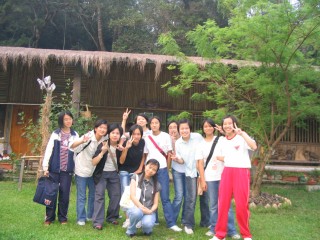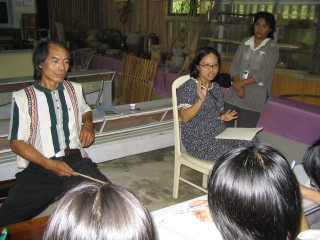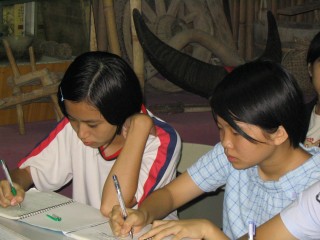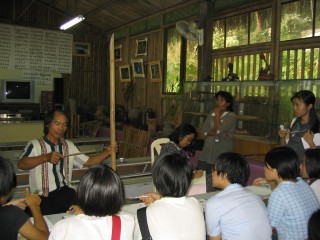|
V.Interview: Siraya
Green Valley | Yi-chia Wang
|Jun-ming Wang
Interview in Siraya Green Valley
| Time: November, 8th, 2003 |
|
| Place: Siraya Green Valley |
| Interviewer (s): 9 students and 3 teachers |
Interviewee (s): Cheng-hsiung Wan, Shu-chuan Wan and Tsui-li
Chou |
Language Revival
Q1: In recent years, what have
you done to revive the Siraya language?
A1: We've held activities in many
different places. And we've used music and dancing to make
everyone know the Pepo Tribe exists in Siraya, to introduce
its culture to the world.
Words from us: If
you know the existence of Siraya culture, please help us promote
it!
Q2: Who helps to revive the Siraya language?
A2: We have people in the Siraya Culture
Association, people who are interested in the Siraya language,
Dutch linguists, Mr. Yi-chia Wan, Miss Shu-chuan Wang, Mr.
Cheng-hsiung Wan, Miss Shu-feng Li, and Professor Chia-yin
Weng. We once got some materials from a Dutch professor on
the Internet.
|
|
| Q3: What's the basis
for language revival?
A3: We made use of some remaining
data to retrieve the missing parts of Siraya language. Around
1624, the Dutch missionaries came to Taiwan. At that time,
the Siraya language was only a spoken language without any
written words. Therefore, the Dutch missionaries recorded
what they had heard in Romanization. About 150 years later,
most parts of Siraya had gone through sinicization, but a
small number of Siraya people still used Romanization. Today,
most of the written data about Siraya are gone. But we have
a "Colletion Hsinkang Documents" which records the
Siraya language. |
Q4: Can you tell us what kinds of data you
have with regard to language revival?
A4: For example, a pig is "ma-u", and "hello"
is "a-li-li."
Words from us:
*Siraya language is similar to the language of Philippines' largest
ethnic groups, "Bisaya." It's possible that Siraya people
are the ancestors of "Bisayas." It is still under study.
*Sin-hua is where the pepo tribe lived. It was called "Da-Mu-Chiang,"
which means "the land of mountains and forests" in the Siraya language.
*In former times, the Siraya language was a language without written
words. To make people learn the Siraya language faster, we sing
songs to help people understand Siraya language better.
Activities over the Years
| Q1: What kinds of activities
do you have?
A1: We have instrumental performances,
dancing performances, plays, etc.
Q2: When do you hold your activities?
A2: Mostly during winter and summer
vacation when our members are available.
Q3: Where do you hold your activities?
A3: In junior high schools, elementary
schools and churches around Tainan County for the most part.
Sometimes local governments may invite us to perform there.
Q4: What's the purpose of these activities?
A4: The purpose is to make Siraya
known to everyone and to introduce the language, music and
culture of Siraya to the world.
Words from us: The
Band of Bamboo Music came first in 1998, and then in 1999,
the Siraya Cultural Association was born.
|
|
See how concentrated we are! |
|
Production of Instruments
Q1: What inspires
you to make instruments?
A1: We create our own instruments. Some
are inspired by the lifestyle of ancient people. We just use
our common knowledge to make them. We make new types of instruments,
too. In short, we want to continue Siraya culture. |
|
The Association
Q1: Why do you found this association?
A1: What concerns me is self identity. Siraya
was an aboriginal tribe in Taiwan. When Siraya people look back
on the past, we kind of think that we don't look exactly like aborigines
in mountains, but we don't look like Han people, either. So, we
Siraya people want to discover ourselves. The establishment of this
association can unite us together to promote some activities. At
the same time, we can make our contributions to local ecology.
Q2: Has the association ever considered giving up looking for Siraya
culture?
A2: Our association did encounter some difficulties,
but we've never thought about giving up.
 The
Summary Record of Interview The
Summary Record of Interview

|



